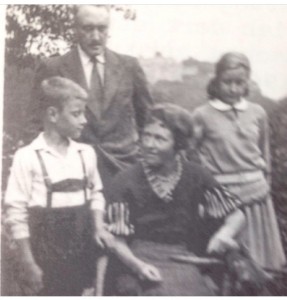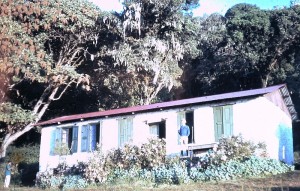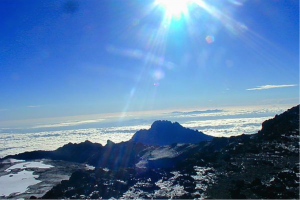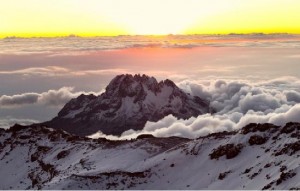When we think of our female ancestors in the early 20th century, we may think of women sitting quietly at home, mending clothes or cooking dinner for their working husbands. This traditional lifestyle was not for my ancestor, however – she wanted something more. Elisabeth “Tucka” Wiegand Müller, born in 1894 in Germany, was an adventurer. At forty years old, on the way to visit her brother in Japan, she happened to meet a man who offered her the chance to climb Kilimanjaro on a whim. She eagerly took it, and became the first German woman in history to make the climb (1934). Below, her firsthand account of the experience, written as a recollection in the 1970s.
Tucka, seated, surrounded by her two children (four years after the climb, 1938)
As the First German Woman on Kilimanjaro: My Memories of September 2, 1934
When I was on a trip from South Africa to Japan, I never would have dreamt that I would have had the opportunity during my short stay in East Africa for a “side trip” to Kilimanjaro. I took full advantage of the opportunity. On the ship was a young Austrian, who had just come back from a safari through Kruger National Park and told me about the two times he had climbed Kibo, the highest peak of Kilimanjaro.
After he proved to be a trustworthy man, I could not refuse his tempting offer to attempt the climb myself under his guidance. I was then housed by some Germans at a coffee plantation in Moschi, where the preparations for the climb could be made. We had to get the keys to the mountain huts from Kibo expert Dr. Reusch, who had often climbed and explored the mountain himself. Local porters also had to be arranged and boots, pith helmets, blankets and supplies had to be ordered. Last but not least, we had to muster up our own courage.
The short rainy season had already begun. It rained so heavily the entire night before our departure that I thought the venture would fall through. But the weather was clear in the early morning, so up we went with one local guide and the four porters carrying loads on their heads.
The path first led us through the jungle – over giant fallen trees and climbing plants and creeks – onwards and upwards through the tracks of elephants. We were always prepared to run into the giants. Their droppings showed us that they had recently been in the area, but that we didn’t need to hurry and get out of there as another expedition had had to do. The monkeys in the trees left us alone, but the humid heat made the hours-long ascent exhausting. Shorts proved to be impractical and the next day we changed into long pants to protect our battered, scratched-up legs. Unfortunately, I’ve since heard the old jungle path is now overgrown and a road has been built up to the Bismarck hut.
Bismarck Hut, 1968
The first night, we stayed at the Bismarck hut, approximately 2,800 meters high; the quality of those huts up there cannot be compared to our German-Austrian Alpine Society huts. After making us a fire and some tea, the boys rolled themselves up in their blankets in the miserable little shed. We had a mattress – or was it a straw pallet? I can no longer remember for sure, but in any case it was quite primitive.
The goal for the second day was Peters Hut (3,800 meters) – also a remnant from the German period in Africa. On our way up, in the midst of cutting winds, we passed through Alpine meadows and bogs and heath thickets that were as tall as us.
The next morning, we departed for the Kibo hut, as high as Mont Blanc. We had to bring our own water and fuel there. The gas oven smoked so much that you got tears in your eyes – we were busy the whole night turning the wick either up or down. We [thought we] would either freeze or suffocate. You couldn’t even think of sleeping and it was impossible to enjoy any food – not the stewed apricot we’d brought with us or a sip of alcohol – even sour candy induced nausea. Then we started to feel like we were getting malaria.
Kibo Hut
And that is how we set off the next morning, not exactly in the best shape, on the last leg of the journey. Would I make it to the top? Dr. Reusch had spoken of a well-trained Oxford team that hadn’t made it to the Kibo peak; there was also an upper-Bavarian guide who had said: “We will make it to the hill” but then came down with mountain sickness and couldn’t do it. Now, in any case, I wanted to attempt it, it was calling to me! The porters remained behind – they were afraid of the mountain spirit – and only the guide went with us. We only brought the bags that were absolutely necessary.
A tremendous struggle began. In the thin air, each step required a hellish effort, especially on the lava rubble. After a few steps, you would always slide back a bit – the next stone was your goal, for catching your breath, or, if possible for falling asleep (but we had constantly been warned that we absolutely could not do that). And so you picked yourself up over and over again and asked yourself what demon had made you take on such an arduous climb. That’s how it was for hours and hours, until finally we reached the edge of the crater, past Leopard’s Point where a frozen leopard was lying on the ground (he had wandered up there and died). The view from Gillman’s Point (5,935 meters) down to the glaciers of Kibo Crater is magnificent. To reach the highest point, Kaiser Wilhelm Peak – named by the first German climber Hans Meyer (1889) and now called Uhuru-Peak – across from Gillman’s Point, you have to go across the edge of the crater or through the crater. But this would have meant another descent and ascent.
Kibo Crater
With the last bit of energy, we carried ourselves up to the peak, unable to really fully savor our success. My guide laid down and was sick. We recorded our names and dates in a book that was kept in a metal box and then gazed out at the unending horizon, quite overcome…However, we could only enjoy this view for a short time, as we were soon engulfed in clouds – a snowstorm was coming.
View from the Peak
We couldn’t put ourselves in that type of situation; we had to go back. During the descent, I had the misfortune to slip on the ice and lose my watch without noticing it right away. So I had to do without it for the entire, rather adventurous return to Mombassa, on the ship to Japan and during my time in the Far East. We made our way down the mountain, more sliding than walking. The soles of my new shoes had not withheld the strain of the ascent and flapped at every step. This of course made the descent more difficult. But then we had made it back to the Kibo hut, so that we could get all our belongings we had left behind. A terrible surprise: they had all disappeared! The rest of the trip down was like a forced march. As the steam ship I had booked was departing soon, we didn’t take any breaks at the huts as we had on the way up.
When we returned to the German brother and sister’s plantation, they knew from looking at us that we had done it, that we had achieved our goal of climbing to the top of Kibo. Our skin was in shreds, in spite of pith helmets and using protective creams . The sun below the equator and the exertion required had left their marks on us all too well.
I still have one wish: In spite of all the effort involved, to be able to go up there one more time, to once again enjoy the view that was granted to me so briefly, to experience in better circumstances that which has left an unforgettable impression on me and now shines on brightly in my memory: the view of snow-covered Kilimanjaro over the loneliness of the endless steppes.
View from Kilimanjaro
Image Credit:
Bismarck Hut: kilimanjaro.bplaced.net
Kibo Hut: kilimanjaro.bplaced.net
Kibo Crater: www.summitpost.org
View from Uhuru Peak: www.africaguide.com
View from Kilimanjaro: https://www.tripadvisor.com/LocationPhotoDirectLink-g293750-d459953-i37483652-Mount_Kilimanjaro-Kilimanjaro_National_Park_Kilimanjaro_Region.html






